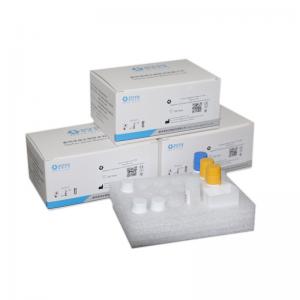

Add to Cart
Chemiluminescencross bone gla protein (BGP) for Automatic immunoassay analyzer in Bone Metabolism
【expected usage】
This product is used to quantitatively detect the content of
osteocalcin (BGP) in human serum in vitro.
Osteocalcin (Osteocalcin), also known as BoneG-Gla Protein (BGP),
is an acidic protein, which is vitamin K-dependent and contains
three γ-carboxyglutamic acid side chains , γ-carboxyglutamic acid
in BGP is very important for its biological properties, and BGP can
be combined with Ca2+ after carboxylation. BGP is one of the most
abundant non-collagen bone proteins in bone, and is ubiquitous in
all vertebrate bones and teeth. It accounts for about 25% of the
total collagen in adult bone. Vitamin K is an indispensable
substance for the synthesis of BGP, and its synthesis is regulated
by 1,25(OH)2D3. The use of vitamin K antagonists can reduce the
content of this protein in bone, but does not affect its proline
content, nor does it affect the mechanical strength of bone.
Osteocalcin is the most abundant non-collagen protein in bones and
is synthesized into the blood by osteoblasts. The half-life in
blood is 4~5min, which is the most sensitive and specific indicator
reflecting the activity of osteoblasts. Osteocalcin values vary
with age and with changes in bone turnover rates. The faster the
bone turnover rate, the higher the osteocalcin value, and vice
versa.
In primary osteoporosis, postmenopausal osteoporosis is a high
conversion type, so osteocalcin is significantly increased; senile
osteoporosis is a low conversion type, so osteocalcin is not
significantly increased. Therefore, it is possible to identify
whether osteoporosis is high-conversion type or low-conversion type
according to the changes of osteocalcin. It should be noted that
osteocalcin is significantly elevated in hyperparathyroid
osteoporosis. , The change of serum BGP concentration is of great
significance to the clinical research on the pathogenesis of bone
diseases and endocrine and metabolic bone diseases and the study of
bone components.
The current clinical and laboratory determination methods for
osteocalcin include enzyme-linked immunosorbent assay, colloidal
gold method, fluorescence immunoassay, and chemiluminescence
method.
| Test item | BGP |
| Specification | 100 Test/Box for CIA series |
| 24 Test/Box for POCT | |
| Principle | sandwich method |
| Component | Magnetic Beads |
| Calibrator Low | |
| Calibrator High | |
| BGP Anti | |
| Control 1 | |
| Control 2 | |
| Accessories Required But Not Provided | Substrate |
| Washing solution | |
| Sample material | serum |
| Sample volume | More than 200μL |
| Storage | 2-8℃ |
Serum Osteocalcin (BGP) Introduction:
Osteocalcin is synthesized and secreted by osteoblasts, which is
relatively stable and is not affected by bone resorption factors.
Serum osteocalcin can be used to understand the activity state of
osteoblasts, especially newly formed osteoblasts.
Osteocalcin values vary with age and with changes in bone turnover
rates. The faster the bone turnover rate, the higher the
osteocalcin value, and vice versa.
In primary osteoporosis, postmenopausal osteoporosis is a high
conversion type, so osteocalcin is significantly increased; senile
osteoporosis is a low conversion type, so osteocalcin is not
significantly increased. Therefore, it is possible to identify
whether osteoporosis is high-conversion type or low-conversion type
according to the changes of osteocalcin. It should be noted that
osteocalcin is significantly elevated in hyperparathyroid
osteoporosis.
Serum osteocalcin (BGP) normal value:
4.8-10.2ug/L.
The clinical significance of serum osteocalcin (BGP):
Elevated: seen in bone synthesis, especially in the early stage of
bone synthesis after bone injury, postmenopausal osteoporosis,
hyperparathyroidism osteoporosis.
